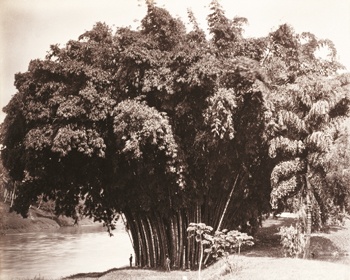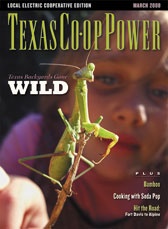Bamboo is not native to Texas but was imported here from Hades.
Actually, that’s not quite true. One species of bamboo, Arundinaria, is native to part of Texas but is usually called “river cane.” Caney Creek in Wharton County was originally called Canebrake Creek after the native river cane that banked its sides.
But for all intents and purposes, most of the bamboo you see growing in Texas, especially in urban areas, is not native. And that’s where people get the idea that it originally served as windbreak along the River Styx. Stories of bamboo infestations and aggressive invasions of the stuff have given it that reputation in some quarters. It’s called “damn-boo” and “the plant that ate the neighborhood” by its detractors.
On the other end of the spectrum, on the banks of Little River in Milam County, Kinder and Mary Len Chambers willingly and happily grow about 60 different kinds of bamboo on their property. They are members of both the Texas and American bamboo societies, and they are bamboo boosters of the first order. But they have heard the horror stories and affirm that some people have had horrendous experiences with bamboo. “There’s no doubt that it’s a problem in some areas,” Kinder readily admits.
The couple won’t defend bamboo to people who are overrun with it, but they want people to know that there are hundreds of varieties of bamboo, and not all of them grow up to act like something from “Little Shop of Horrors.” They believe that golden bamboo (Phyllostachys aurea) has sullied the reputation of other, more benign varieties. This is the plant that people generally talk about when they talk about the plant that ate their neighbor’s yard.
It’s important to know that there are basically two types of bamboo—running and clumping. The runners are the ones that can take over a landscape if given half a chance. The clumpers grow much more slowly. The bulb-shaped rhizomes (underground stems) on clumping varieties are short, and new shoots, called culms, come up closer to the parent. The long, far-ranging rhizomes on running bamboo can extend for some distance and are jointed with nodes at which a culm or another rhizome can grow. Leave running bamboo alone and it will lift sidewalks and driveways and even come up through the floorboards inside houses in its insatiable desire to become Lord of the Flora. If someone is talking to you about “damn-boo,” they are likely talking about a variety of running bamboo.
Kinder and Mary Len don’t suggest trying to dig the roots out of already established problem bamboo. Because the roots must have leaves to draw energy from the sun, he suggests divorcing the roots from the sun by killing every shoot that comes up. The shoots will come back, but each time they will be smaller until they don’t bother coming back at all.
If the bamboo grove is not already too well established, if it hasn’t already devoured the neighborhood or countryside, he suggests pruning the roots. But, he admits, “That’s a pretty big chore for an already existing grove.”
In urban settings, he suggests using a sharp, narrow shovel and digging in about 6 to 8 inches. Don’t expect to find a taproot, because you won’t. Farmers, or people with a considerable amount of acreage, can use a tractor and subsoiler to do the job.
The pair first got interested in bamboo as a means of erosion control along the portion of Little River that runs through their land. They were losing about 2 feet a year to erosion.
Their place is a demonstration farm for growers and prospective growers of bamboo. They have a bamboo treehouse, bamboo furniture and a bamboo stair railing. Members of the Texas Bamboo Society can get cuttings from the Chambers’ farm for free. First-timers pay $40 for their cutting, which is used to make them official members of the society.
“We’re available for any kind of information about bamboo that you might want,” Kinder says. “If you want to know how to grow it, we’ll show you how to grow it. If you want to get rid of it, we’ll show you how to do that too.”
Bamboo enthusiasts suggest that anybody worried about controlling running bamboo should get a clumping variety. “Some of the clumping types are beautiful,” said Danielle Kaplan, office manager for Utility Research Garden in Austin. “The look is different. It grows a little each year and is easier to control. The fear that most people have when they plant bamboo is that it will run and take over the neighbor’s yard.”
To make sure that doesn’t happen she suggests using in-ground root barriers to not only control the spread of the plant but to shape the bamboo stand that you want to grow. The barriers are plastic and flexible, allowing you to grow the bamboo stand in whatever shape you desire. She concedes that sometimes it will jump the barrier.
“When that happens, just hack it off,” she suggests.
Container bamboo can be placed outdoors or even indoors by a sunny window. “We’re trying to get the word out that bamboo can make really nice indoor or container plants,” Kaplan says.
Others are trying to get the word out that bamboo should be avoided as a dangerous invasive. Bamboo showed up on the “Texas’ Least Wanted List” at a conference on invasive species at the Lady Bird Johnson Wildflower Center in Austin last year. Andrea DeLong-Amaya, director of gardens and growing, believes that a little bit of knowledge can go a long way in deciding whether or not bamboo is right for you or your landscape.
“The main thing is to find a species that won’t be invasive,” she says. “People considering bamboo should ask themselves why they want it and then determine if there is a native species that will suit their purposes just as well.
“For example, if you like a lush look, horsetail might do just as well.”
——————–
The Texas Bamboo Society meets on the third Saturday of the month at Taniguchi Japanese Garden in the Zilker Botanical Gardens in Austin. You can contact Kinder Chambers via e-mail at [email protected].
Clay Coppedge is the state writer for Country World newspaper. He lives and works near Walburg.


